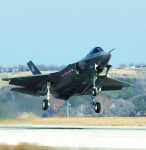AF releases draft document on F-35 proposal

With Mountain Home Air Force Base still a contender for a new fighter mission, the Air Force last week released a draft version of a document outlining its potential impact here.
Disseminated to local officials and the general public, the draft environmental impact statement outlines the potential basing of an operational F-35 fighter unit here or at four other stateside installations.
In July 2010, Mountain Home Air Force Base was identified as a "reasonable alternative" for the next-generation fighters with other installations listed higher up in this initial basing decision.
In addition, the Idaho Air National Guard at Gowen Field was included on a separate short list to serve as a potential F-35 training base.
The F-35 is a multi-service jet designed to replace the Air Force's fleet of veteran F-16s. Originally, the Air Force planned to put 200 to 300 F-35s in service each year beginning in 2015. However, issues with the fighter's development put that timeline years behind schedule.
At one point, the Air Force intended to field a total of 1,700 of these jets. Simply put, even if it's not selected as an initial base for these jets, Mountain Home remains a candidate in future basing decision rounds, base officials said in a previous interview with the Mountain Home News.
Starting May 8, the Air Force will host a series of public meetings in the local area regarding the draft environmental impact statement. These face-to-face gatherings will allow the public to ask questions and air concerns before the Air Force releases a final version of this report.
Spanning more than 1,100 pages, the two-volume document outlines the potential impact this fighter program will have at each of six bases previously selected as potential beddown locations for these fighters. They include Burlington Air Guard Station, Vt.; Hill Air Force Base, Utah; Jacksonville Air Guard Station, Fla.; McEntire Joint National Guard Base, S.C.; and Shaw Air Force Base, S.C.
The report examines issues related to land use, airspace and safety, air and water quality, noise, socioeconomics, biological and cultural resources as well as cumulative actions.
The aircraft transition plan in this document looked at the possibility of basing up to three F-35 squadrons at Mountain Home Air Force Base. The addition of just one squadron here would boost the number of jets at the base to 80 with that number jumping to 128 under the three-squadron option.
According to the draft document, the base would gain a minimum of 532 airmen if it gains at least one operational F-35 squadron. Under a three-squadron plan, that number would increase to nearly 1,600 more military personnel and another 160 civilian contractors -- about a 39 percent increase compared to current base population figures.
Out of the base's current military population, more than 1,300 personnel are assigned to directly support its existing F-15 flight operations, which includes the Republic of Singapore air force detachment.
It would require up to 21 separate facility construction, modification and renovation projects to support three squadrons of these jets here at an estimated cost of nearly $52 million, according to the report. At a minimum, the base would need to add or modify four existing facilities under the one-squadron option.
Among the facilities needed to accommodate the F-35s here are a new munitions storage area and inspection facility as well as a parts storage hangar and flight simulator complex.
Should the Air Force reverse its earlier decision and move Mountain Home up to the initial basing list, construction here could start as early as 2013, the report indicated.
Increased jet noise -- a concern aired at previous public hearings on the F-35 -- isn't expected to have as great of an impact here, according to the report. At takeoff, the fighter generates about 116 decibels of noise, which equals the amount produced by the base's F-15 fleet. While the next-generation fighter's noise footprint is actually less than the F-15 during landings and pattern flying, that noise level does increase during overhead break maneuvers.
Meanwhile, the F-35 takeoff and landing procedures are similar to those used by the base's F-15 fleet and "would adhere to existing flight restrictions and avoidance procedures," the report said. Less than a half percent of its expected flight training would occur between 10 p.m. and 7 a.m. In comparison, 12 percent of the base's current F-15 flights, or sorties, happen during these nighttime hours.
In addition, the draft report indicated that the fighter's noise contour, or "footprint," would not readily exceed an established baseline of 65 decibels. Off-base areas within this noise contour were identified as open, agricultural land with no residential areas underneath. The exception is a single ranch west of the base, which falls within the 75 to 80 decibel contour.
Turning to other environmental issues, jet emissions from these fighters would increase. However, they would remain within all federal and state air quality guidelines, according to the report.
"The area enjoys good air quality, and none of the (three basing) scenarios would introduce emissions that would affect regional air quality," it stated.
Meanwhile, the report identified no impact to wildlife, threatened and endangered species, wetlands or plant life attributed to the fighter itself. While increased flights from the base would increase the possibility of collisions between these jets and birds, the F-35 flies at higher altitudes, which reduces this risk.
Air Force officials emphasized that the initial basing decisions for the F-35 were not final. Air Force officials will conduct additional analysis and public hearings until a final decision is made. However, it's rare for a base identified as a "preferred alternative" to be rejected at this point in the process, officials said.
